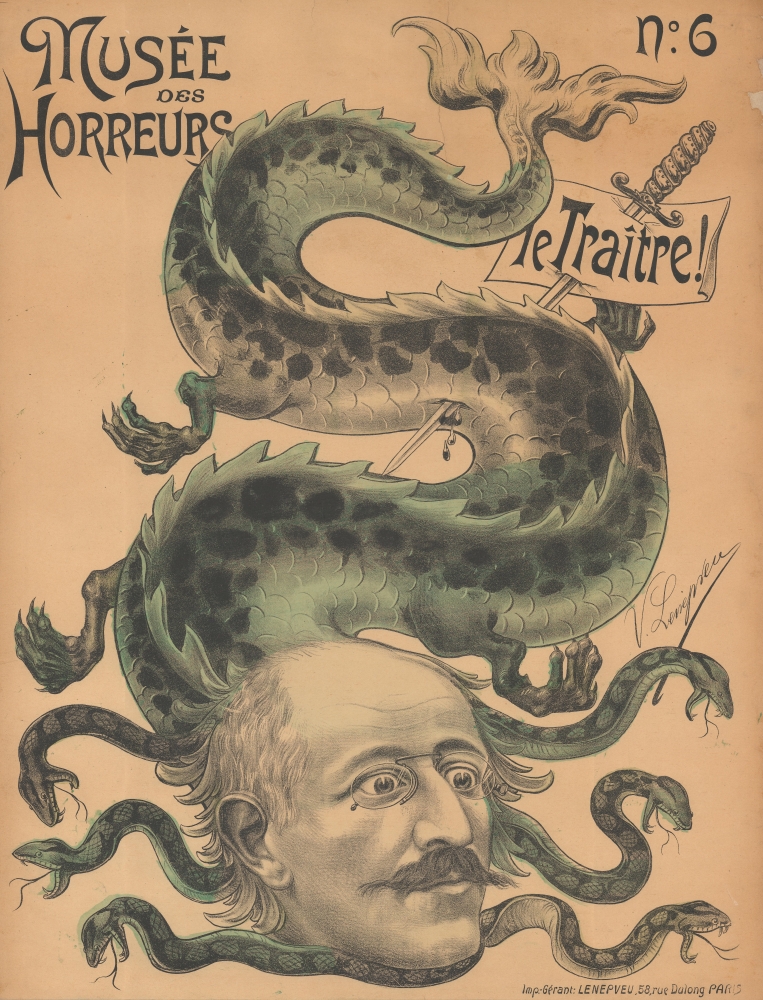1899 Lenepveu 'Musée des Horreurs' Antisemitic Broadside of Alfred Dreyfus as a Hydra
MuseeHorreurs6Traitre-lenepveu-1899
Title
1899 (undated) 25.5 x 19.25 in (64.77 x 48.895 cm)
Description
A Closer Look
This dramatic chromolithograph broadside was part of the media storm generated by the Dreyfus Affair. It is the key broadside of the 51-sheet series. This broadside bears a frightfully chimeric caricature of Dreyfus as a hydra, suggesting that his treasonous actions were not an act of an individual but that his traitorous actions would have 'many heads,' like a hydra. This piece was published in November 1899, two months after Dreyfus was pardoned. It is the central piece in the Musées des Horreurs.The 'Musées des Horreurs'
The Musées des Horreurs was a series of 51 nationalist anti-Dreyfus broadsides published by Auguste-Victor Lenepveu between October 1899 and December 1900. The series was aimed at Alfred Dreyfus and his supporters, including Émile Zola, Georges Clemenceau, Jean Jaurès, and the Rothschild family. The therianthropic caricatures had the faces of these personalities attached to the bodies of animals and mythical creatures. Lenepveu initially announced that 150, then 200 drawings would be published, but the Musées des Horreurs was shut down by French police after the first 51. People could buy the broadsides individually, or they could subscribe and have them sent to their homes. Despite an initially wide circulation, the Musées des Horreurs broadsides were officially censured and actively sought by authorities who confiscated and destroyed all those found.The Dreyfus Affair
The Dreyfus Affair centered around a French military officer named Alfred Dreyfus (1859 - 1935). Born in Mulhouse, Alsace, as the youngest child of a textile manufacturer, the Dreyfus family moved to Paris in 1871 after Germany annexed Alsace after the Franco-Prussian War. Dreyfus graduated from military school in 1880, attained the rank of captain, and, in 1893, was assigned to the French Army General Staff headquarters, where he was the only Jew.In the fall of 1894, the French intelligence services discovered that a French military officer had sent secret documents to the military attaché at the German embassy in Paris. This act of treason was investigated, and despite evidence making it unlikely that Dreyfus was the traitor, he was arrested on October 15, 1894, based on a handwriting analysis enhanced by anti-Jewish prejudice. A farcical court-martial followed, where the proceedings were stacked against Dreyfus. Evidence included 'a file of secret and in some cases forged documents' presented by the Ministry of War that Dreyfus's attorney was not allowed to review. Dreyfus was found guilty and sentenced to life in prison. He was dishonorably discharged from the French Army on January 5, 1895, and sent to the penal colony on Devil's Island, French Guiana.
While Dreyfus languished in prison, his family fought to prove his innocence. The new chief of the French Intelligence Services, Lieutenant Colonel Georges Picquart, also did not believe in Drevfus's guilt. After new evidence came to light, Picquart pushed to have the implicated officer, Major Ferdinand Walsin Esterhazy, investigated. However, his superiors did not want the case reopened, so Picquart was soon transferred to Tunisia. Nevertheless, the evidence against Esterhazy made its way to the French Senate, where Senator Auguste-Scheurer-Kestner declared Dreyfus's innocence on January 13, 1898. At the same time, L'Aurore published Emile Zola's celebrated open letter titled J'accuse! in which he criticized the government for its antisemitism, judicial errors, lack of evidence, and illegal jailing of Dreyfus. Zola was subsequently found guilty of criminal libel and fled to England to avoid imprisonment. He stayed there until he was granted amnesty in 1899.
The case was nonetheless reopened during the summer of 1898, and the forgeries used in the original proceedings were discovered. A retrial still found Dreyfus guilty, but his sentence was reduced due to 'extenuating circumstances.' Under overwhelming public pressure, Emile Loubet, the President of the Republic, pardoned Dreyfus. Dreyfus was set free on September 20, 1899, but was not officially exonerated until July 12, 1906. At this time, he was reinstated into the military at his former rank and served out the remainder of his career with distinction.
Publication History and Census
This broadside was created and published by Victor Lenepveu c. 1898. We note cataloged examples at Johns Hopkins University, Duke University, the Jewish Museum, the Victoria and Albert Museum, and the Musée d'Art et d'Histoire du Judaïsme. Lenepveu published 51 broadsides in this series (sold both by subscription and individually), published weekly after Dreyfus's retrial in the fall of 1899.Cartographer
Auguste-Victor Lenepveu (July 21, 1852 - 19??) was an Algerian artist, journalist, and antisemite. Born in Oran, French Algeria, by 1891 he was living in Colombes, in the Seine-et-Oise region of France and working as a journalist. Lenepveu is only remembered as the creator of the antisemitic propaganda collection known as the Musée des horrors. Most sources on this topic suggest that Lenepveu was a pseudonym, but interviews in Parisian newspapers, including Le Libre Parole show otherwise. In one interview, published on October 15, 1899, he describes himself as an 'Algerian and antisemite'. The Musée des horrors was forced to cease publication in 1900 by French authorities, and a second collection of cartoons entitles Musée des patriots ceased publication in 1901. In 1901 Lenepveu is identified as the president of the Comité républicain nationaliste des Batignolles (the Republican Nationalist Committee of Batignolles). His last appearance in the historical record is in April 1902 as a member of the Republican Nationalist Committee. More by this mapmaker...

